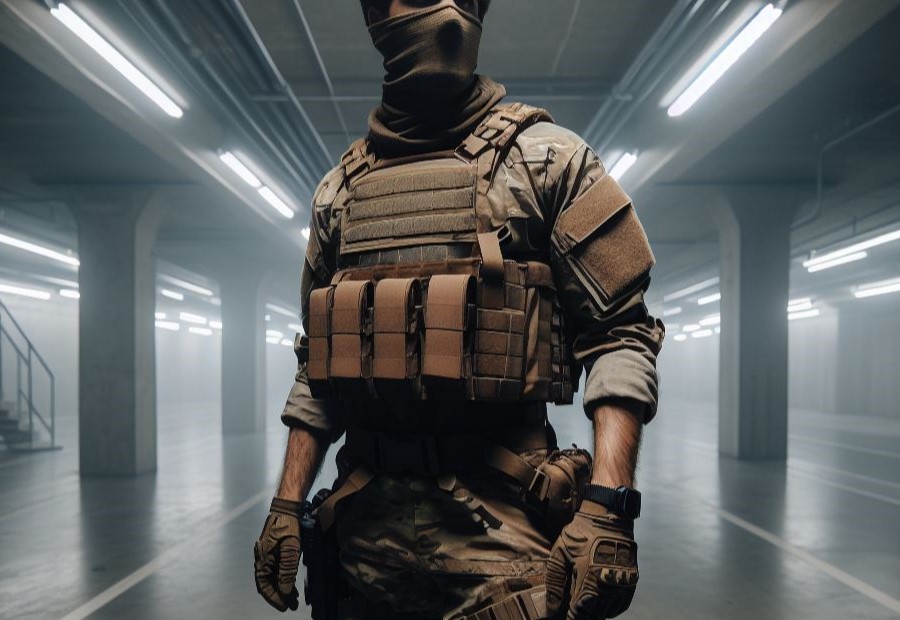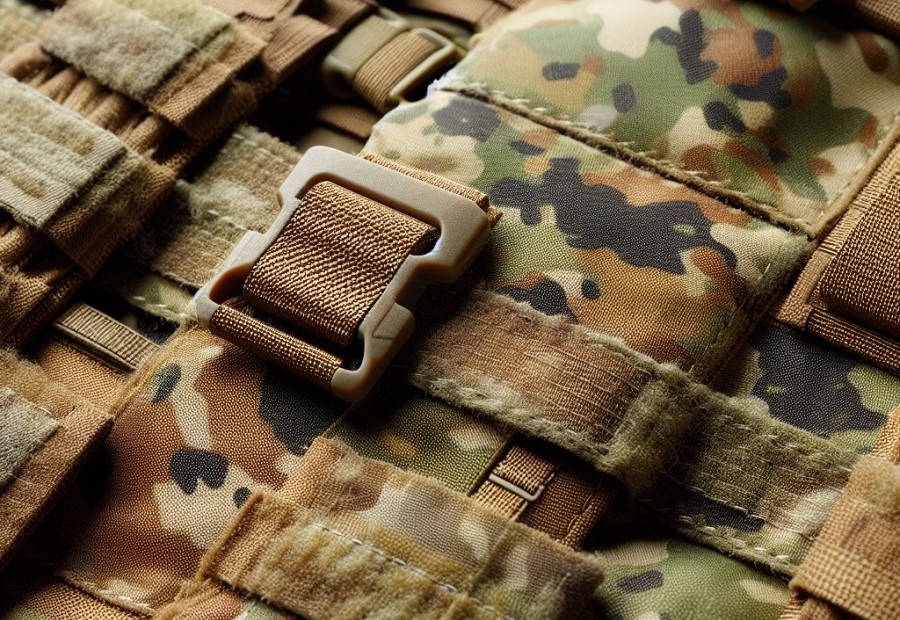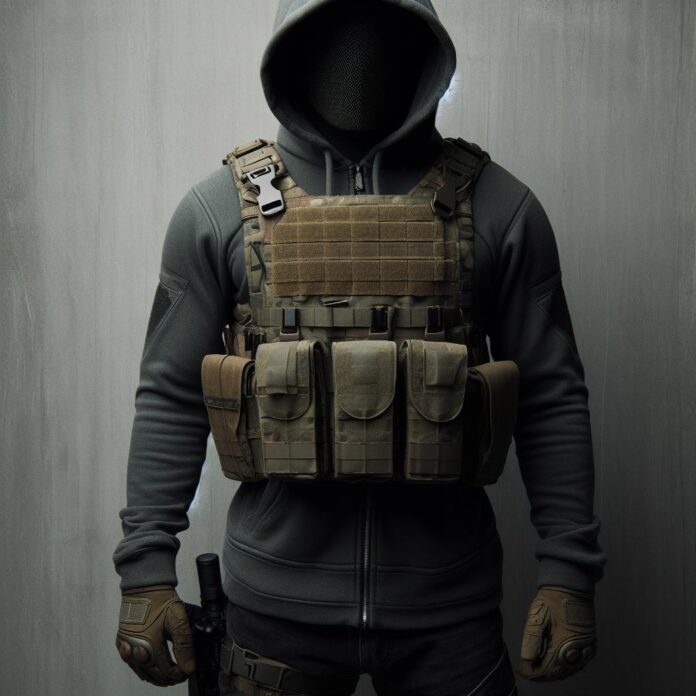Tactical clothing is specially designed apparel worn by military, law enforcement personnel, and outdoor enthusiasts to provide functionality, durability, and comfort in challenging situations.
Understanding the materials used in tactical clothing is essential to comprehend its unique properties and benefits.
Specific standards and certifications, such as MIL-STD (Military Standard) and NFPA (National Fire Protection Association), ensure that tactical clothing materials meet specific performance and safety requirements.
Understanding the materials used in tactical clothing enables users to make informed choices based on their specific needs, ensuring they have the right gear for optimal performance and protection.
What Materials are Used in Tactical Clothing?

Ripstop Nylon
Ripstop nylon is a versatile and durable fabric commonly used in tactical clothing. It is created using a special weaving technique that forms a grid pattern, enhancing the fabric’s resistance to tearing and ripping.
The grid pattern reinforces the fabric, preventing small tears from spreading and expanding. With its lightweight yet durable nature, ripstop nylon is ideal for outdoor activities and rugged environments.
Ripstop nylon is renowned for its outstanding strength to weight ratio, delivering reliable protection without adding unnecessary bulk or weight.
Due to its abrasion resistance, this fabric is suitable for activities involving frequent contact with rough surfaces. In addition, ripstop nylon provides good water resistance, helping to keep the wearer dry in wet conditions.
Moreover, it dries quickly, making it a practical choice for activities where moisture management is crucial.
Polyester
| Material | Properties | Usage |
| Polyester | Polyester is a synthetic fabric known for its durability and resistance to wrinkles, shrinking, and fading. | Polyester is commonly used in tactical clothing due to its excellent strength and abrasion resistance. It is also lightweight and dries quickly, making it suitable for outdoor activities and extreme weather conditions. |
Pro-tip: When choosing tactical clothing, look for items made with polyester for their durability and resistance to wear and tear. Polyester is also a great option for those who need clothing that can withstand rugged activities and harsh environments.
Cotton Blend
One of the materials used in tactical clothing is a cotton blend. A cotton blend is a fabric composed of a combination of cotton and other fibers, such as polyester or spandex, to enhance its performance and durability.
Here is a table highlighting the properties of a cotton blend:
| Property | Description |
| Durability | A cotton blend fabric is known for its strength and resistance to tearing, making it suitable for rugged outdoor activities. |
| Comfort | The cotton fibers in the blend provide a soft and breathable feel, ensuring comfort even during extended wear. |
| Flexibility | The addition of spandex or other stretch fibers allows the cotton blend fabric to stretch and move with the wearer, providing freedom of movement. |
| Moisture-wicking | A cotton blend fabric has the ability to absorb perspiration from the body and evaporate it, keeping the wearer dry and comfortable. |
| Easy care | Cotton blends are usually easy to care for, as they can be machine washed and dried without significant shrinkage or wrinkling. |
A cotton blend is a versatile choice for tactical clothing as it combines the natural comfort of cotton with added performance benefits. It offers durability, flexibility, breathability, and easy maintenance, making it suitable for various outdoor activities or daily wear.
Spandex
Spandex is a popular material used in tactical clothing due to its stretch and flexibility. It offers several advantages when incorporated into the design of tactical garments.
- Flexibility: Spandex has excellent elasticity, allowing for a wide range of motion during strenuous activities. It stretches and moves with the body, providing comfort and freedom of movement.
- Comfort: The stretchiness of spandex ensures a snug and comfortable fit, preventing restrictions and discomfort while wearing tactical clothing.
- Durability: Spandex is a durable material that can withstand the rigors of intense physical activity. It is resistant to tears and abrasions, making it ideal for tactical use.
- Moisture-wicking: Spandex has moisture-wicking properties, which means it helps to draw sweat away from the body, keeping the wearer cool and dry during high-intensity situations.
- Quick-drying: As spandex is moisture-wicking, it dries quickly, minimizing the risk of sweat-soaked clothing, discomfort, and chafing.
- Compression: Spandex offers compression, which can support muscles and reduce fatigue during long periods of physical activity.
Incorporating spandex into tactical clothing provides a combination of comfort, flexibility, durability, and moisture-wicking properties necessary for optimal performance in tactical situations.
Its ability to stretch and conform to the body ensures a comfortable fit that allows for a wide range of motion without sacrificing durability.
Gore-Tex
Gore-Tex is a popular material used in tactical clothing. It is a waterproof, breathable fabric that provides excellent protection against the elements.
The key aspect of Gore-Tex is its ability to repel water while allowing moisture to escape, keeping the wearer dry and comfortable.
This is achieved through a unique membrane that consists of microscopic pores. These pores are large enough to allow sweat vapor to pass through but small enough to keep water droplets out.
In addition to its waterproof and breathable properties, Gore-Tex is also known for its durability. It is designed to withstand rugged conditions and can endure repeated use without losing its effectiveness.
Many tactical clothing brands incorporate Gore-Tex into their products because of its reliability and performance.
Whether it’s tactical pants, jackets, or gloves, Gore-Tex ensures that the wearer stays dry and protected in various weather conditions.
Gore-Tex was invented by Wilbert L. Gore and Robert W. Gore in 1969. Originally, the fabric was developed for use in medical implants.
However, its exceptional properties caught the attention of outdoor enthusiasts and the military. Since then, Gore-Tex has become a staple material in the outdoor and tactical clothing industry.
It has earned a reputation for its ability to provide reliable protection in even the harshest environments. Today, Gore-Tex continues to be a go-to choice for those seeking high-performance gear that can withstand the elements.
Kevlar
Kevlar is a strong and lightweight synthetic fiber that is often used in tactical clothing. It is known for its exceptional strength-to-weight ratio, making it five times stronger than steel on an equal weight basis.
Kevlar is highly resistant to cuts, punctures, and abrasions, providing excellent protection against potential hazards in tactical situations.
Its high tensile strength and low weight make it ideal for applications where durability and flexibility are critical.
When incorporated into tactical clothing, Kevlar helps to reduce the risk of injury from sharp objects, projectiles, or impacts.
It provides an additional layer of defense without compromising the overall flexibility and functionality of the garment.
Kevlar has a fascinating history. It was invented by Stephanie Kwolek, a chemist working for DuPont, in the mid-1960s.
Originally, Kevlar was developed as a replacement for steel reinforcement in racing tires. However, its incredible strength and resistance to impact and abrasion led to its adoption in various other industries.
Why are These Materials Used in Tactical Clothing?

Durability and Abrasion Resistance
Durability and abrasion resistance are crucial factors to consider when choosing tactical clothing.
The materials used in tactical clothing are specifically selected to ensure durability and the ability to withstand rigorous activities.
When choosing tactical clothing, look for materials like ripstop nylon, polyester, cotton blends, spandex, Gore-Tex, and Kevlar to ensure durability and abrasion resistance.
These materials offer exceptional tear and abrasion resistance, strength, resistance to stretching, shrinking, and wrinkles, comfort, flexibility, waterproof properties, and high-strength synthetic fiber to withstand tough conditions and heavy-duty applications.
Additionally, consider the specific activities you will engage in and the environmental conditions you will encounter to select the most appropriate clothing.
Moisture Wicking and Breathability
Moisture wicking and breathability are crucial factors to consider for optimal comfort and performance when it comes to tactical clothing.
Tactical clothing with ‘moisture-wicking properties’ is designed to pull sweat away from the body and transport it to the outer surface of the fabric.
This helps to keep you dry and prevents sweat from lingering on the skin, reducing the risk of discomfort, chafing, and odor.
‘Breathable tactical clothing’ allows air to circulate freely, improving ventilation and preventing the buildup of heat and moisture. This helps to regulate body temperature and maintain comfort, especially during intense physical activities.
‘Moisture-wicking and breathable tactical clothing’ is particularly important for outdoor activities where you may encounter various weather conditions. It helps to keep you cool in hot and humid environments while also providing insulation in colder weather.
By keeping you dry and comfortable, moisture-wicking and breathable tactical clothing can enhance your performance during physical activities. It allows you to focus on the task at hand without distraction or discomfort.
Various synthetic fabrics such as polyester, nylon, and spandex are commonly used in tactical clothing due to their moisture-wicking and breathable capabilities. These fabrics are known for their quick-drying properties and ability to allow air circulation.
Flexibility and Stretch
When it comes to tactical clothing, flexibility and stretch are crucial. The ability to move freely and comfortably is essential in tactical situations that require agility and quick reflexes. Here are some key points to consider:
- Fabric technology: Look for fabrics such as spandex or polyester blends that naturally offer stretch. These materials allow for greater flexibility and freedom of movement.
- Design and construction: Tactical clothing should have strategic paneling and design elements that enhance flexibility. Look for features like articulated knees, gusseted crotches, and stretch panels in critical areas.
- Range of motion: Test the garment’s range of motion by performing movements like squats, lunges, and arm swings. Ensure that the clothing allows for a full range of motion without any restrictions.
- Durability: While flexibility and stretch are important, it’s also crucial to choose clothing that is durable and can withstand the rigors of tactical situations. Look for tear-resistant and abrasion-resistant fabrics.
- Fit: Proper fit is essential for optimal flexibility. Avoid clothing that is too tight or too loose, as it can hinder movement. Look for options that offer a balance between a comfortable fit and freedom of motion.
Water and Wind Resistance
When it comes to tactical clothing, water and wind resistance are important features to consider. These attributes can significantly impact the functionality and comfort of the clothing in various outdoor and tactical situations.
- Water Resistance: Tactical clothing with water resistance is specifically designed to repel water, keeping you dry even in wet conditions. This is achieved through the use of specialized fabrics or coatings that prevent water from penetrating the clothing. Look for tactical clothing that is labeled as water-resistant or waterproof for optimal protection.
- Wind Resistance: Wind-resistant tactical clothing is specifically designed to block or reduce the effects of wind, keeping you warm and shielded from strong gusts. Such clothing is typically made from tightly woven fabrics or may include wind-blocking materials. Choosing wind-resistant tactical clothing is crucial in cold and windy environments to maintain comfort and prevent wind chill.
When selecting tactical clothing with water and wind resistance, consider the specific conditions you will be facing and the level of protection you require.
Additionally, pay attention to any additional features that enhance water and wind resistance, such as sealed seams or adjustable cuffs. Prioritize reputable brands known for their expertise in producing high-quality tactical gear.
Remember, staying dry and protected from the elements is essential to maintaining optimal performance during tactical operations or outdoor activities.
By choosing tactical clothing with water and wind resistance, you can ensure your comfort and focus on the task at hand even in challenging environments.
Heat and Flame Resistance
When selecting tactical clothing, it is important to take into account the heat and flame resistance of the materials used.
Ripstop nylon, polyester, and cotton blends offer different levels of heat and flame resistance. Ripstop nylon and polyester provide good resistance, while certain cotton blends can offer flame resistance when treated with special finishes.
On the other hand, spandex is not known for its heat and flame resistance but is often included in tactical clothing for its stretch and flexibility properties.
For exceptional heat and flame resistance, materials like Gore-Tex and Kevlar are highly recommended.
Gore-Tex provides excellent protection against extreme temperatures and fire, while Kevlar is renowned for its exceptional resistance to heat and flames.
Remember to choose the right materials that meet your specific needs and safety requirements. Stay safe and protected with tactical clothing that offers reliable heat and flame resistance.
Are There Any Specific Standards for Tactical Clothing Materials?

Tactical clothing often requires specific materials to meet the demands of various environments and activities.
While there might not be universal standards, there are common characteristics and qualities that tactical clothing materials should possess:
- Durability: Tactical clothing needs to withstand rugged conditions, abrasions, and wear and tear. Materials like ripstop nylon, Cordura®, and heavy-duty polyester blends are commonly used for their strength and resilience.
- Breathability: Comfort is crucial during extended wear, especially in warm climates or during physical activity. Fabrics with moisture-wicking properties and breathable membranes like Gore-Tex® help regulate body temperature and keep the wearer dry.
- Flexibility and Mobility: Tactical clothing should allow for a wide range of motion without restricting movement. Stretch fabrics or articulated designs in key areas like the knees and elbows enhance flexibility and comfort.
- Weather Resistance: Depending on the intended use, tactical clothing may need to provide protection against various weather conditions, including rain, wind, and snow. Water-resistant coatings, windproof membranes, and insulation layers can all contribute to weatherproofing.
- Lightweight Construction: While durability is essential, tactical clothing should also be lightweight and packable for easy transport and mobility, especially for military and outdoor enthusiasts.
- Fade Resistance: Colors should resist fading, particularly if the clothing will be used in outdoor environments where exposure to sunlight is frequent. Fabrics treated with UV inhibitors or solution-dyed materials are more resistant to fading.
- Fire Resistance: In some tactical situations, fire resistance is critical for safety. Fabrics treated with flame-retardant chemicals or inherently flame-resistant fibers like Nomex® provide added protection.
- Noise Reduction: Tactical operations often require stealth, so clothing materials should minimize rustling or other noise that could give away the wearer’s position. Soft, brushed fabrics or noise-dampening coatings can help reduce sound.
While there may not be specific standards governing tactical clothing materials, manufacturers often adhere to industry best practices and guidelines to ensure their products meet the demanding requirements of military, law enforcement, and outdoor enthusiasts.
Additionally, organizations like the National Institute of Justice (NIJ) and ASTM International may provide testing and certification for certain performance attributes, such as ballistic resistance or flame resistance, in tactical gear.
Frequently Asked Questions
What is tactical clothing made of?
Tactical clothing is made of versatile everyday workwear materials designed to meet the needs of professionals in various fields, including military and paramilitary personnel.
These materials are chosen for their durability, comfort, and functionality.
What are some examples of abrasion-resistant materials used in tactical clothing?
Abrasion-resistant materials commonly used in tactical clothing include CORDURA, which is a fabric known for its exceptional durability and resistance to wear and tear.
NyCo Extreme is another lightweight and rugged fabric often used in tactical clothing and gear.
How durable is tactical clothing for outdoor use?
Tactical clothing is designed to be highly durable and withstand outdoor environments. It is made with fabrics like polyester, cotton, and nylon, which are chosen for their ability to resist wear, shrinking, and fading.
These materials ensure that tactical clothing can withstand substantial abuse during outdoor activities.
Can tactical clothing be worn in cold water?
Tactical clothing is generally not designed for submersion in cold water. While the materials used in tactical clothing may provide some degree of water resistance, prolonged exposure to cold water can compromise their effectiveness.
It is recommended to wear specific cold water gear or waterproof outer layers for activities involving significant water exposure.
Can tactical clothing be dry cleaned?
Tactical clothing is typically not recommended for dry cleaning. The specialized materials and finishes used in tactical clothing may not react well to the chemicals and processes involved in dry cleaning.
It is best to refer to the care instructions provided by the manufacturer for proper cleaning and maintenance of tactical clothing.
Is tactical clothing only for military and paramilitary personnel?
Tactical clothing, while commonly worn by military and paramilitary personnel, is also suitable for a wide range of professions and outdoor activities.
It is versatile everyday workwear designed for professionals in fields such as law enforcement, security, emergency medical services, and firefighting.
Tactical clothing provides comfort, durability, and practical features for anyone in need of functional and reliable apparel.

